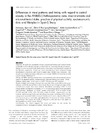Identificador persistente para citar o vincular este elemento:
http://hdl.handle.net/10553/35437
| Título: | Differences in meal patterns and timing with regard to central obesity in the ANIBES (‘Anthropometric data, macronutrients and micronutrients intake, practice of physical activity, socioeconomic data and lifestyles in Spain’) Study | Autores/as: | Aparicio, Aranzazu Rodríguez-Rodríguez, Elena Aranceta-Bartrina, Javier Gil, Ángel Gonzalez-Gross, Marcela Serra-Majem, Lluis Varela-Moreiras, Gregorio Ortega, Rosa M. |
Clasificación UNESCO: | 3206 Ciencias de la nutrición | Palabras clave: | Waist-to-height ratio Obesity Central obesity Timing Variety |
Fecha de publicación: | 2017 | Publicación seriada: | Public Health Nutrition | Resumen: | Objective: To study the association of meal patterns and timing with central obesity to identify the best dietary strategies to deal with the increasing obesity prevalence. Design: A cross-sectional study performed on data from a representative sample of the Spanish population. Height and waist circumference were measured using standardized procedures and waist-to-height ratio (WHtR) was calculated. The sample was divided into those without central obesity (WHtR< 0.5) and those with central obesity(WHtR >= 0.5). Setting: ANIBES ('Anthropometric data, macronutrients and micronutrients intake, practice of physical activity, socioeconomic data and lifestyles in Spain') Study. Subjects: Adults aged 18-64 years (n 1655; 798 men and 857 women). Results: A higher percentage of people ate more than four meals daily in the group without central obesity and those with central obesity more frequently skipped the mid-afternoon snack than those without. Breakfasts containing > 25% of total energy intake and lunches containing > 35% of total energy intake were associated with increased likelihood of central obesity (OR = 1.874, 95% CI 1.019, 3.448; P< 0.05 and OR= 1.693, 95% CI 1.264, 2.268; P< 0.001, respectively). On the contrary, mid-morning snacks and mid-afternoon snacks containing > 15% of total energy were associated with decreased likelihood of central obesity (OR= 0 . 477, 95% CI 0.313, 0.727; P < 0.001 and OR= 0.650, 95% CI 0.453, 0.932; P < 0.05, respectively). The variety of cereals, wholegrain cereals and dairy was higher in the population without central obesity. Conclusions: Our results suggest that 'what and when we eat' should be considered dietary strategies to reduce central obesity. | URI: | http://hdl.handle.net/10553/35437 | ISSN: | 1368-9800 | DOI: | 10.1017/S1368980017000635 | Fuente: | Public Health Nutrition [ISSN 1368-9800], v. 20 (13), p. 2364-2373 |
| Colección: | Artículos |
Citas SCOPUSTM
23
actualizado el 30-mar-2025
Citas de WEB OF SCIENCETM
Citations
24
actualizado el 30-mar-2025
Visitas
77
actualizado el 04-may-2024
Descargas
114
actualizado el 04-may-2024
Google ScholarTM
Verifica
Altmetric
Comparte
Exporta metadatos
Los elementos en ULPGC accedaCRIS están protegidos por derechos de autor con todos los derechos reservados, a menos que se indique lo contrario.
